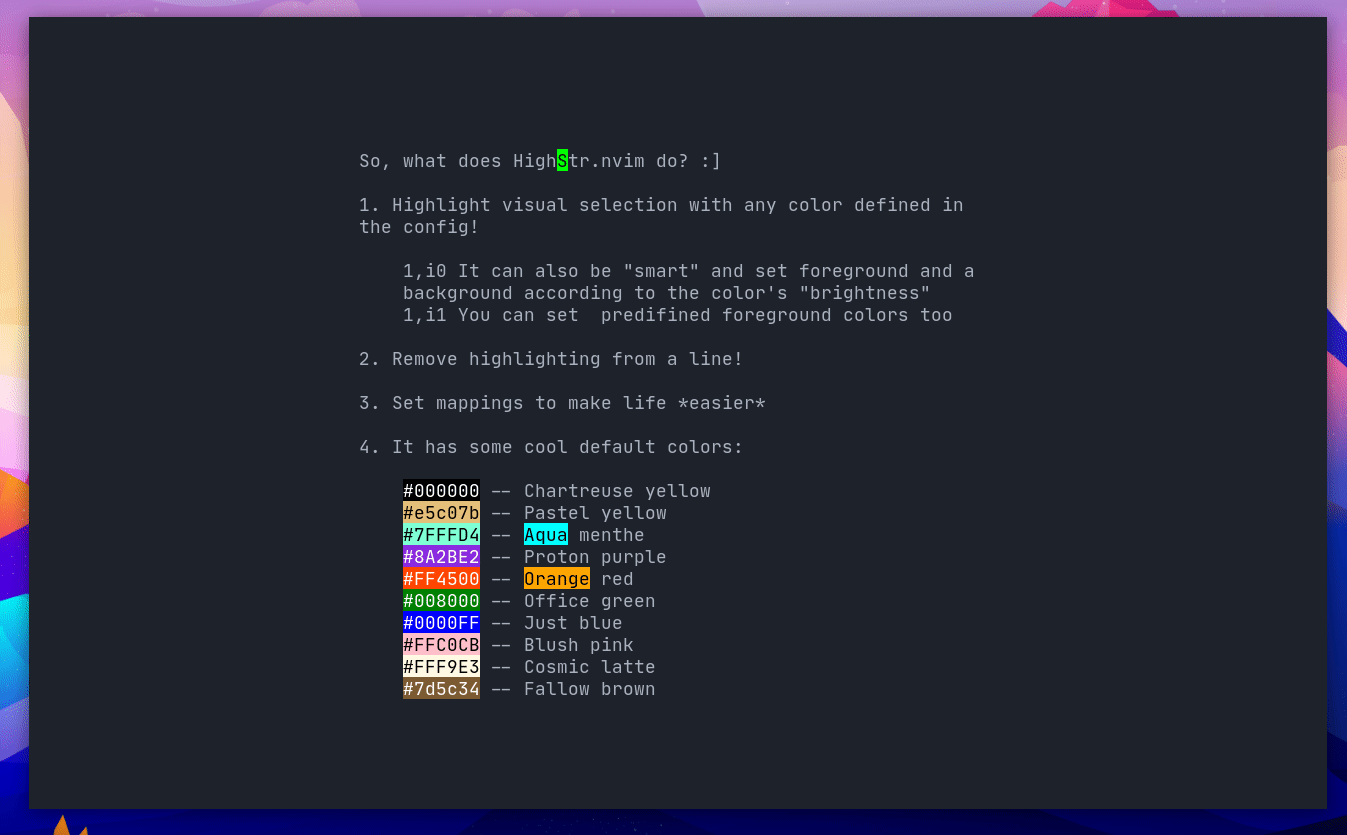HighStr.nvim
HighStr.nvim is a NeoVim plugin written in Lua that aims to provide a the simple functionality of highlighting text like one would do in a normal document editor. To use it, install it with your favorite plugin manager, select something in visual mode and then run :HSHighlight. You can also add keybindings to the commands.

? Features
- Highlight visual selection in any given pre-defined color.
- Remove highlighting from lines in visual selection.
- Users can set up foreground and background of any color.
- Has a "smart" option to set foreground based on background.
- Users can add any amount of colors.
- Produce a verbose output for debugging (optional).
? Notices
Checkout the CHANGELOG.md file for more information on the notices below:
- 26-05-21: Fixed bug that prevented adding new colors and added option to remove all highlighting from the current buffer
- 25-05-21: Just released!
? Installation
Prerequisites
- NeoVim nightly (>=v0.5.0)
- A nice color scheme to complement your experience ;)
Adding the plugin
You can use your favorite plugin manager for this. Here are some examples with the most popular ones:
Vim-plug
Plug 'Pocco81/HighStr.nvim'
Packer.nvim
use "Pocco81/HighStr.nvim"
Vundle
Plugin 'Pocco81/HighStr.nvim'
NeoBundle
NeoBundleFetch 'Pocco81/HighStr.nvim'
Setup (configuration)
As it's stated in the TL;DR, there are already some sane defaults that you may like, however you can change them to match your taste. These are the defaults:
verbosity = 0,
highlight_colors = {
color_0 = {"#0c0d0e", "smart"}, -- Cosmic charcoal
color_1 = {"#e5c07b", "smart"}, -- Pastel yellow
color_2 = {"#7FFFD4", "smart"}, -- Aqua menthe
color_3 = {"#8A2BE2", "smart"}, -- Proton purple
color_4 = {"#FF4500", "smart"}, -- Orange red
color_5 = {"#008000", "smart"}, -- Office green
color_6 = {"#0000FF", "smart"}, -- Just blue
color_7 = {"#FFC0CB", "smart"}, -- Blush pink
color_8 = {"#FFF9E3", "smart"}, -- Cosmic latte
color_9 = {"#7d5c34", "smart"}, -- Fallow brown
}
The way you setup the settings on your config varies on whether you are using vimL for this or Lua.
For init.lua
local high_str = require("high-str")
high_str.setup({
verbosity = 0,
highlight_colors = {
-- color_id = {"bg_hex_code",<"fg_hex_code"/"smart">}
color_0 = {"#0c0d0e", "smart"}, -- Cosmic charcoal
color_1 = {"#e5c07b", "smart"}, -- Pastel yellow
color_2 = {"#7FFFD4", "smart"}, -- Aqua menthe
color_3 = {"#8A2BE2", "smart"}, -- Proton purple
color_4 = {"#FF4500", "smart"}, -- Orange red
color_5 = {"#008000", "smart"}, -- Office green
color_6 = {"#0000FF", "smart"}, -- Just blue
color_7 = {"#FFC0CB", "smart"}, -- Blush pink
color_8 = {"#FFF9E3", "smart"}, -- Cosmic latte
color_9 = {"#7d5c34", "smart"}, -- Fallow brown
}
})
For init.vim
lua << EOF
local high_str = require("high-str")
high_str.setup({
verbosity = 0,
highlight_colors = {
-- color_id = {"bg_hex_code",<"fg_hex_code"/"smart">}
color_0 = {"#0c0d0e", "smart"}, -- Cosmic charcoal
color_1 = {"#e5c07b", "smart"}, -- Pastel yellow
color_2 = {"#7FFFD4", "smart"}, -- Aqua menthe
color_3 = {"#8A2BE2", "smart"}, -- Proton purple
color_4 = {"#FF4500", "smart"}, -- Orange red
color_5 = {"#008000", "smart"}, -- Office green
color_6 = {"#0000FF", "smart"}, -- Just blue
color_7 = {"#FFC0CB", "smart"}, -- Blush pink
color_8 = {"#FFF9E3", "smart"}, -- Cosmic latte
color_9 = {"#7d5c34", "smart"}, -- Fallow brown
}
})
EOF
For instructions on how to configure the plugin, check out the configuration section.
Updating
This depends on your plugin manager. If, for example, you are using Packer.nvim, you can update it with this command:
:PackerUpdate
? Usage (commands)
All the commands follow the camel casing naming convention and have the HS prefix so that it's easy to remember that they are part of the HighStr.nvim plugin. These are all of them:
Default
:HSHighlight <integer>highlights current visual selection and receives an<integer>that indicates which colors to use from thehighlight_colors = {}table; if none is given, HighStr.nvim will pickcolor_1.:HSRmHighlight <rm_all>If therm_allargument is given, removes all the highlighting in the current buffer. If not, does the same but for every line in visual selection.
? Configuration
Although settings already have self-explanatory names, here is where you can find info about each one of them and their classifications!
General
This settings are unrelated to any group and are independent.
verbosity: (Integer) if greater that zero, enables verbose output (print what it does when you execute any of the two command).
Highlight Colors
The table highlight_colors = {} contains all of the colors HighStr.nvim will use when you highlight something. The convention is simple: color_<a_number>. Each color is a table in which the first element represents the background of the color (the highlight it self), and the second one represents the foreground (the color of the text that's being highlighted). The second parameter may also be the word "smart", to change the color of the foreground based on the background in order to get a better contrast (e.g. if background is white, set foreground to black). Here is an example:
color_1 = {"#FFF9E3", "smart"}
Here we are setting a cool color called Cosmic Latte (looks like white), that we are assigning to color_1 and we are giving its parameters to a table: the first one is the highlight itself ("#FFF9E3") and in the second one ("smart") we are telling it to set a foreground that will make contrast with the background (black in this case).
Conditions:
- The numbers that are assigned to the colors (e.g.
color_2) should not be repeated, because it's what you'll use to "call" that highlight color. - The color it self (argument one in a color's table) should be in its hex value.
? Key-bindings
There are no default key-bindings. However, you can set them on your own as you'd normally do! Here is an example mapping <F3> to highlight stuff and <F4> to remove the highlighting:
For init.lua
vim.api.nvim_set_keymap(
"v",
"<F3>",
":<c-u>HSHighlight 1<CR>",
{
noremap = true,
silent = true
}
)
vim.api.nvim_set_keymap(
"v",
"<F4>",
":<c-u>HSRmHighlight<CR>",
{
noremap = true,
silent = true
}
)
For init.vim
vnoremap <silent> <f3> :<c-u>HSHighlight 1<CR>
vnoremap <silent> <f4> :<c-u>HSRmHighlight<CR>



